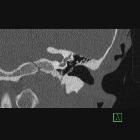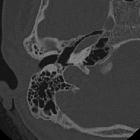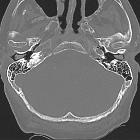myringosclerosis



Myringosclerosis refers to the calcification and thickening of the tympanic membrane.
Epidemiology
Myringoscleorsis is usually seen in children, with a reported incidence of 28%-61% of all patients treated with tympanostomy tubes .
A case of myringosclerosis has been reported in a two-year-old infant .
Clinical presentation
It is usually an asymptomatic condition .
If sclerosis affects large areas of the tympanic membrane with extension to the handle of malleus or bony annulus, the function of the drum will be reduced, leading to conductive hearing loss .
In otoscopy, it's seen as white, 'chalky' plaques in the tympanic membrane.
Pathology
Myringosclerosis is secondary to calcification and hyalinization of the connective tissue of the tympanic membrane .
These changes are thought to be caused by long-term inflammation, in which collagen fibers are destroyed, and replaced by exudate with granulation tissue .
Intraepithelial hemorrhages in a post-traumatic setting e.g. myringotomy can heal by fibrosis, leading to myringosclerosis
Etiology
Myringosclerosis is usually sequelae of:
- inflammation
- chronic otitis media
- otitis media with effusion
- trauma
- myringotomy
- tympanostomy tube placement
- other
- atherosclerosis: some studies suggested a relation between calcium deposit in the tympanic membrane and carotid arteries
Radiographic features
CT
HR-CT of the temporal bone demonstrates thickened, and calcified tympanic membrane.
Treatment and prognosis
Myringosclerosis is not treated if asymptomatic.
If the sclerotic plaques are adherent to the head of the malleus and the bony annulus, with substantial fixation of the drum, surgical removal of the scar tissue may be performed in association with a tympanoplasty .
Differential diagnosis
The main differential to consider is tympanosclerosis, in which the sclerotic plaques extend beyond the tympanic membrane reaching the ossicular chain and the tympanic cavity.
Siehe auch:
- Trommelfell
- chronische Mittelohrentzündung
- fenestrale Otosklerose
- chronische Otomastoiditis mit Tympanosklerose
- Tympanosklerose
- Myringosklerose
und weiter:

 Assoziationen und Differentialdiagnosen zu Myringosklerose:
Assoziationen und Differentialdiagnosen zu Myringosklerose:



